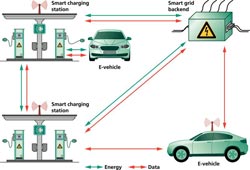Communication for E-vehicle energy management systems

The use of smart grids in the field of electromobility calls for the development of new communication interfaces. Copyright: formidee designbüro<br>
The aim is to create a system in which electric vehicles use and temporarily store energy. The charging station serves as an active node that communicates with the vehicle and an energy management system in the smart grid.
One of the benefits for drivers is access to variable energy rates. This approach also allows the energy provider or grid operator to integrate the electric vehicle into the energy management system of the smart grid.
Digital information flow for more convenient driving
As part of the SmartV2G project, engineers analyzed all of the information flows needed to support vehicle-to-grid integration. Using this information as a basis, they identified the relevant infrastructure components, designed the underlying communication architecture and derived the functional and technical specifications. The communication path was then implemented and evaluated. The extensive communication that occurs between the energy management system and the electric vehicle – whether at the charging station or on the road – provides a more convenient driving experience and leads to improved energy efficiency and lower costs.
Information such as location, opening hours, number of open charging stations, current energy rates and available payment options will provide drivers a range of benefits. Charging stations situated within the vehicle’s estimated operating range can be reserved even while driving. Another advantage for drivers involves taking into account individual preferences such as planned driving routes and simplified billing models, which are made possible through automatic vehicle identification. Time-shifted charging makes optimal use of the grid’s capacity, a feature that can eventually contribute to maintaining a stable energy network. This is a key issue for energy providers and operators because sufficient renewable energy supplies are not always on-hand and that means drivers have to be highly flexible. In the end, consumers, energy providers and grid operators will all reap significant benefits from the SmartV2G project innovations.
Globalizing E-vehicles through standards
Researchers are creating a uniform, manufacture-independent specification for the E-vehicle-to-charging station communication through ISO/IEC15118. This standard defines a comprehensive exchange of information that is essential for the “smart” charging process. Communication between the charging station and the smart grid will be based on an enhancement of the IEC 61850 global standard. Fraunhofer ESK researchers are the driving force behind the further development of the IEC61850-90-8 specification, which to date has been available in draft form. By combining the two standards, the charging station is transformed into a node that integrates the electric vehicle charging process into the smart grid.
Demonstrator
A demonstrator developed by Fraunhofer ESK runs through the entire information chain, from the vehicle to the control center energy management system. This results in the exchange of a variety of information such as battery status, charging progress, charging mode, authentication data and price and payment information.
The SMARTV2G (smart vehicle-to-grid interface) project is being funded through the European Union’s Seventh Framework Program (FP7).
PR & Marketing Contact
Marion Rathmann | Fraunhofer Institute for Embedded Systems and Communication Technologies ESK | Tel +49 89 547088-395
Hansastraße 32 | 80686 München | www.esk.fraunhofer.de | marion.rathmann@esk.fraunhofer.de |
Media Contact
More Information:
http://www.esk.fraunhofer.de/en/media.htmlAll latest news from the category: Power and Electrical Engineering
This topic covers issues related to energy generation, conversion, transportation and consumption and how the industry is addressing the challenge of energy efficiency in general.
innovations-report provides in-depth and informative reports and articles on subjects ranging from wind energy, fuel cell technology, solar energy, geothermal energy, petroleum, gas, nuclear engineering, alternative energy and energy efficiency to fusion, hydrogen and superconductor technologies.
Newest articles

Properties of new materials for microchips
… can now be measured well. Reseachers of Delft University of Technology demonstrated measuring performance properties of ultrathin silicon membranes. Making ever smaller and more powerful chips requires new ultrathin…

Floating solar’s potential
… to support sustainable development by addressing climate, water, and energy goals holistically. A new study published this week in Nature Energy raises the potential for floating solar photovoltaics (FPV)…

Skyrmions move at record speeds
… a step towards the computing of the future. An international research team led by scientists from the CNRS1 has discovered that the magnetic nanobubbles2 known as skyrmions can be…





















